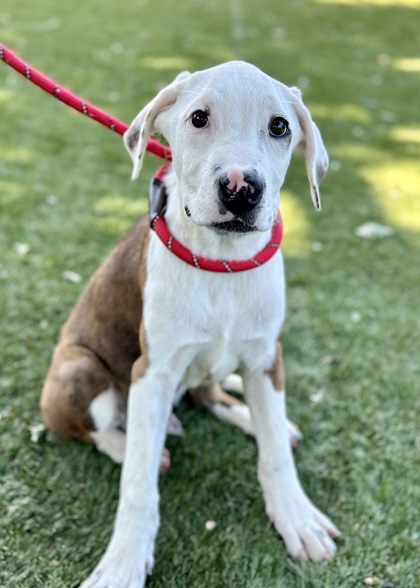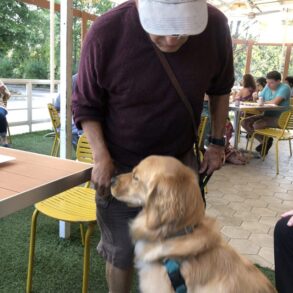
We had a deaf dog, and from her we learned that deaf dogs don’t care that they are deaf. We learned that deaf dogs are just dogs and, like people, have their own quirks and personalities. I tell you this for two reasons.
The first is to let you know that presently, at the Tehama County Animal Care Center, 1830 Walnut Street, Red Bluff (530-527-3439), there is a sweet pup who could use someone to help him grow and navigate the world. Pirate came into the shelter with his brother Moo, who has since been placed with a foster to adopt. Both dogs, by all indications, are deaf. However, they will blossom in a home that will love and nurture them.
The second reason is that Deaf Dog Awareness Week is September 22-28. It is estimated that about 35,000 dogs in the United States are deaf in both ears. Dogs who are deaf in just one ear, about 120,000, are more common. In addition, more than 30 breeds of dogs have a known susceptibility for deafness. The week becomes an opportunity for pet owners, and anyone interested in the health and welfare of animals to learn how to support the deaf dog community and raise awareness about this condition, which affects so many.
Deaf dogs really do make amazing pets. Anything heard to the contrary is cloaked with misunderstanding. The only genuine limitation is that a deaf dog should not roam freely unless there is a secure, safe area available for them to do so. A deaf dog cannot hear danger approaching, like a car. Otherwise, a deaf dog trains as easily as any other dog. The only difference is that one must use non-verbal signals, rather than verbal commands.
For most of these dogs, deafness is hereditary. And for nearly all, it is associated with piebald or merle coat patterns. (Merle is a pattern in a dog’s coat. The merle gene creates mottled patches of color in a solid or piebald coat, blue or odd-colored eyes, and can affect skin pigment as well.) So, almost any dog with white in its fur or any “blue” dog might be more likely to be deaf. The Deaf Dog Education Fund (http://www.deafdogs.org/ ) says, “The most common cause of congenital deafness is pigment related. If there is unpigmented skin in the inner ear, the nerve endings atrophy and die off in the first few weeks of the puppy’s life, resulting in deafness.”
Like any training, you must first get the attention of your student. Deaf dogs will not respond to you calling their name but will react with other types of stimuli. Stomping your foot on the ground causes vibrations that can be felt. Waving a flashlight, or clicking it on and off, usually garners attention. One can also use a vibrating collar, which differs substantially from “shock” collars. These collars only vibrate and are not distressful to the animal.
When teaching basic commands to any dog, the use of hand signals is common practice. Therefore, training a deaf dog using them is perfectly natural. Some people create their own set of hand signs for particular words like sit, stay, down, walk etc., while others learn a few basic words in American Sign Language. Whatever you choose to do, the signal must remain consistent, so the animal associates the “word” and the action. Lastly, never strike a deaf dog with your hands! Hands are how you communicate with the animal and should always be positive, reassuring tools.
A common myth is that deaf dogs are more aggressive. The reasoning is that if you startle a deaf dog, they will bite. Any dog, whether deaf or not, when startled may snap or snarl out of fear. Therefore, it is important to work with the dog so he is comfortable having someone come from behind and touch him. A few times a day, wake the dog by very gently touching its shoulder or back, then reward immediately with a treat. If you do not want to startle the dog, stomp your foot or bump the bed they are sleeping on, the vibration will awaken them. Again, always provide a reward.
Deaf dogs typically bond strongly with their guardians. They are affectionately known as “Velcro” dogs. As with hearing dogs, some may develop separation anxiety. However, the training methods to condition them to be unafraid of being alone are the same as it is for any other dog. Always remember, deaf dogs can do agility, therapy, etc., almost anything a hearing dog can do. There is nothing wrong with them. They are simply dogs who cannot hear.
If you are thinking of adding a deaf canine companion to your life, in addition to the Deaf Dog Education Action Fund, (http://www.deafdogs.org/) website, there is Deaf Dogs Rock (https://deafdogsrock.com/) and books, “A Deaf Dog Joins the Family” by Terrie Hayward, and “Living With a Deaf Dog” by Susan Cope Becker which may prove helpful.
As author Charlotte Schwartz wrote, ”For perhaps, if the truth were known, we’re all a little blind, a little deaf, a little handicapped, a little lonely, a little less than perfect. And if we can learn to appreciate a dog’s full potentials, we will, together, make it in this life on earth.” I couldn’t agree more. Why not give aa deaf dog a chance?
This post was originally published on this site be sure to check out more of their content.
















































